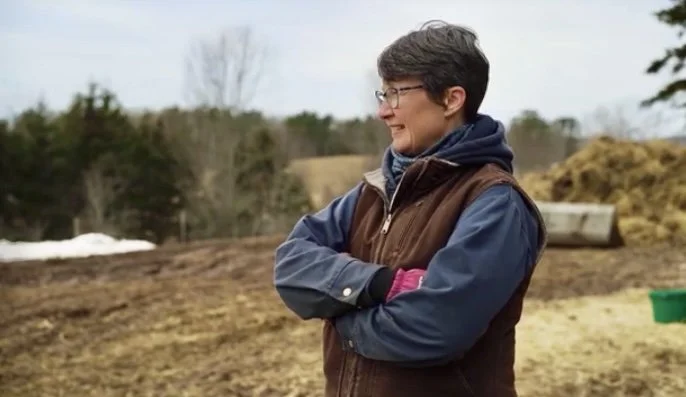Adapting and adopting
How drought is impacting Nova Scotia farmers, and what they’re doing about it.
Catherine Manning. Photo courtesy of Manning Family Farm.
The array of products available from Catherine Manning’s farm might be smaller this year, as drought conditions — the most severe to hit Nova Scotia in years — take a toll on the province’s water resources.
Aware that drought events might become a more regular occurrence, farmers in the province are considering how they might adapt and adopt (new measures) for the future.
Manning and her family operate a mixed vegetable and beef farm near the Falmouth area in the province’s Annapolis Valley. Like many Nova Scotian farmers, they started the year with intentions to provide local markets with their usual range of vegetables, such as sweet corn, squash, carrots, potatoes, and onions. Dependent on a nearby brook for irrigation water, a lack of meaningful rain this summer has forced them to prioritize irrigating crops that “are still going to make a little money.”
“We haven’t experienced drought like this since we’ve been on the farm, and we’ve been on the farm since 1997,” says Manning, adding that water levels in the brook from which they draw have dropped considerably over the summer.
“We’re trying to be really conservative about where we put the water. We’ve never had to do that before.”
It’s not just vegetables, either. The most concerning thing for Manning is how once lush pastures used to feed their beef cattle herd are increasingly dry and parched. This has meant very little regrowth of much needed fodder (animal feed). Some of their herd is also located on rented pastureland near areas threatened by wildfires, meaning her family has to be ready to move their animals out of harm’s way on short notice.
“To be honest, our customers today, they feel our pain,” Manning says. “We appreciate their support. It doesn’t go unnoticed that there are a lot of people who worry about us.”
Manning’s situation is not unique. In her position as second vice president for the Nova Scotia Federation of Agriculture, she says farmers across the Maritimes are looking for short term stop-gap solutions to their water woes, while considering ways of safeguarding their livelihoods when drought and fire risk return in subsequent years.
For Dustin Swinkels, Antigonish-area dairy farmer and vice-chair of Dairy Farmers of Nova Scotia, the danger posed by wildfires is significant and acute. Moving 400 cows away from an approaching fire is no small task. A lack of drought tolerance in their pastures, however, is a more chronic problem.
“Last year we took five cuts of grass silage (feed made by preserving grass through a fermentation process) off. It was hard to get a window when it was dry enough to harvest,” says Swinkels.
The scale of drought this year is, by contrast, something he says he “couldn’t have ever anticipated.” Although Swinkels has several wells from which he can draw the significant volumes of water required to sustain his dairy cattle, and for cleaning the barn, other farmers have been forced to bring water in by truck.
“You find you’re looking things up, like how much water it would take to irrigate. Usually, it’s the other way around,” he says. You don’t wish for rain, because it will come and never stop.
With limited surface water across much of the province, however, most Nova Scotia farmers wouldn’t be able to irrigate their pastures or crops, even if they wanted to.
For now, he says most livestock farmers have entered the 2025 cropping year with “pretty good inventories” — that is, sufficient stocks of feed to get their animals though the rest of the year. Low crop prices also mean those who do have to purchase animal feed are not breaking the bank to do so. But with drought-induced crop yield losses this year, farmers are increasingly reliant on good conditions in 2026 to make up for the shortfall.
One bad year, says Swinkels, is usually manageable, but two bad years in a row is “what will get you.”
Farmers still have agency, of course, and are taking steps to reduce their vulnerability wherever possible. For Swinkels, that means building feed inventory by expanding crop production and not selling as much feed so they are “sitting on bigger piles of feed all the time.” He also suspects a lot of farmers will be digging more water wells in the coming months.
Manning agrees and is herself considering increasing the number of ponds on their farm, as well as deepening existing ponds. Her family has also focused on increasing how much feed they have on hand, on top of maintaining a high level of wildfire emergency preparedness.
What crops they provide to the community may change, too.
“This year is certainly bringing to light what crops do best in dry conditions. We’ll definitely be looking at that going forward,” she says.
Climate Stories Atlantic is an initiative of Climate Focus, a non-profit organization dedicated to covering stories about community-driven climate solutions.
Sign up for notifications of our latest free articles. You can unsubscribe at any time.

